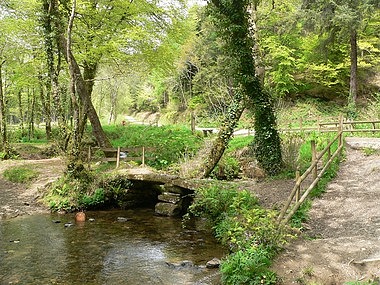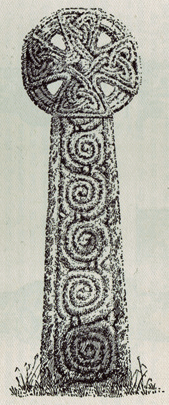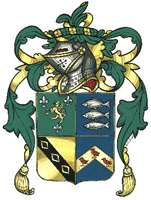 |
| Cardinham woods |
Central Cornwall
This page is still under construction
please call again
Glynne of Glynne Manor
You have read of the advantage marriage of John Trevithen to Margery
Glynn back in the 1500’s and the fact that her brother lived in the St.
Merryn parish, the home ground of the Trevethan family. It is thought
that this may well be how John and Margery happened to meet as the Glynn
family resided in Cardinham parish a short distance east of St. Merryn.
The Glynne family was a powerful and wealthy one, owning Glynne
manor, two and a half miles south of Cardinham and a little to the east
of Bodmin. Seems the family first lived at Glynne from at least 1370.
In the 1400’s there was a period when the feud between the Courtenays,
Earls of Devon, and the Bonvilles reached its climax over a dispute
about the stewardship of the Duchy of Cornwall. In 1455 the Earl even
attacking Exeter Cathedral with his retainers. These retainers, little
private armies in the pay of the nobility and gentry, were a legacy of
the French war and a curse of the time, and it was to be one of Henry VII’s first acts to abolish them. At a level lower was the feud between
Thomas Clemens and John Glyn of Morval over the deputy-stewardship of
the Duchy. The story is one of unbelievable ferocity and lawlessness,
culminating early one Saturday in August when Clemens’s men lay in wait
for Glyn and, ‘at four o’clock in the morning horribly slew and murdered
him, clove his head in four parts and gave him ten dead wounds in his
body, and when he was dead cut off one of his legs, and one of his arms
and his head from his body to make him
 sure’(1). It is a measure of the
anarchy of the time that although numerous warrants were issued for the
arrest of Clemens, he was still at large in 1476 when he is last heard
of. sure’(1). It is a measure of the
anarchy of the time that although numerous warrants were issued for the
arrest of Clemens, he was still at large in 1476 when he is last heard
of.
The first of the Glynne family of interest to us is Nicholas who was
born ca 1513 and inherited Glynne manor from his father Thomas. Nicholas
married three times firstly to Constance Brian who died without giving
birth to any children. His second wife was Elizabeth Talkern and their
first son William was born in 1534. His brothers and sisters were
Nicholas, Mary and of interest to us Margery who went on to marry John
Trevethwan.
Nicholas senior was a man of some substance and it seems that he held
the manor of Glynn on lease from the Courteneys family. By 1558 he was
assessed to have lands in Cardinham valued at seven pounds which by the
time of his death had risen to ten pounds. At that moment in time he
owned more than thirty properties including the moiety(2) of the Manor
of Treire in Lanreath, the Manor of Manely in St. Vepe, one messuage(3)
and forty acres of land in Cardinham called Glyn, one messuage in
Brodoke called Polwater, and one messuage called Penbugell which he gave
to his son Nicholas. The mention of Penbugell is interesting as some
three hundred years later John Trevethan was to lease this farm from a
John Glencross.
In 1572 for “various considerations specially moving me” Nicholas
Glyn had prepared in duplicate a special document conveying his varies
amounts of land to a group of family and friends who would hold it for
his benefit during the remainder of his lifetime, and pass it on his
death in accordance with his instructions. This group of people who in
effect were trustees of his estate consisted of Nicholas Carmynowe (his
brother John’s father-in-law), Robert Trencreke (his brother John’s
daughter-in-law’s father) and William Courtenye of Deviock, Esquires,
John Crewes (father of is daughter-in-law), Thomas Trevythuan (perhaps
an uncle of John Trevithan) and John Glyn of Boyton
 |
| Cardinham Cross |
(his brother),
Gentlemen. Perhaps this document was prepared as a result of Nicholas
not being of good health. Until 1537 or thereabouts it was the only
general method of making a will of land. Wills of this period commonly
come in two parts: one, often in Latin, consisting of instructions about
money, animals, jewellery and so on, and the other in English, with
instructions about the house and fields.
The fact that Thomas Trevythuan was appointed along with some other
rich and inferential men shows that at this time the Trevethan’s were a
family of some substance.
When Nicholas died in October of 1580 he left a most interesting
will. His, by this time third wife Johanna, was to inherit forty pounds,
a vast sum of money in those days. Also she was to have his second best
gelding, two cows and ten ewes along with grassing for them at Glynne as
long as she was willing to dwell at Glynne.
Nicholas must have been very fond of his daughter Margery’s children
for her eldest son Robert Trevethvane from St. Ervan was given twenty
pounds, while his brother Sampson got forty shillings and brothers,
William and John twenty shillings each.
Each of his godchildren were left one sheep as were each of his
household servants. His younger son Nicholas received his fox fur gown
and his other daughter Mary Harry, two oxen, two cows, eight ewes and
four wethers.
The large holding of land and tenements that Nicholas had in
Crinacott, Pyworthy, Black Torrington, Chilla and Chipping Torrington in
the county of Devon were all left to his younger son Nicholas Glynne.
The manor of Glynne and all his remaining estate passed to his heir
and eldest son William Glynne, the brother of our Margaret Glyn, who
continued to build the family assets by acquiring of one messuage with
200 acres of land in Glyn, a messuage with 140 acres in Kingswood Hill
and other places in Cardingham. His son was to become the Sheriff of
Cornwall in 1620.
Three months after Nicholas Glyn died, an Inquisition Post Mortem of
his estates was held and from this most amazing document we find out
just how rich and powerful he had been. For he owned parcels of land
with many messuages and tenements scattered all over north east Cornwall
and further west even into Devon . He held land In at least twelve
parishes in Cornwall which amounted to at least 1200 acres and many more
pieces the size of which is not known. Much of the land is described as
pastures, meadow or gorse and heath but there were also some woodlands.
An Inquisition Post Mortem was the equivalent of today’s estate or
death duties. An heir could not enter upon his inheritance until he had
paid certain dues to the Crown, the feudal theory being that all
belonged to the King and an estate reverted to the Crown on the tenant’s
death. A tax called a “relief”, then became due to the King and the heir
had to pay this before he could take possession of the property; he also
had to pay homage and only after both had been done could he receive of
his inheritance. On the death of a tenant-in-chief, the royal officer in
the county, known as the escheator, received a writ which ordered him to
empanel a jury to ascertain: the lands held by the late tenant, the
rents or services by which they were held, the names and age of the
heir. If there was no heir, the land escheated (reverted) to the Crown;
if the next heir was under age the Crown claimed rights of wardship over
the lands and the heir until he came of age. The returns were made upon
oath. All this finished in 1660 when feudal tenures were abolished.
Nicholas arranged that on his death the estates were to go to his
sons in “fee tail”; that is, his sons were to have the estates for there
life time, and the estates were to then go to his son’s actual
descendants according to the rules then in force for the descent of land
on death when the owner did not make a will. Basically, this was to the
owner’s eldest son, or failing that to the daughters in equal shares,
down through all generations. If the son had no children, or his
descendants died out, the estates were to go to the heirs of Nicholas.
The effect of this arrangement was to keep the estates in the family of
his son for as long as possible, and to make it practically impossible
for his son or his descendants to sell or mortgage the property.
As such an arrangement made it exceedingly difficult for later
generations to make family settlements of this kind to suit their own
circumstances, a way had been invented about a hundred years before this
of turning “fee tail” into “fee simple” or freehold by means of a dummy
lawsuit known as “suffering a common recovery”.
At that time, to complete the passing of title to land, it was
necessary to have not only a deed but also “livery of seisin”, which was
performed traditionally by going personally onto the land and handing
over a piece of turf, so that the neighbours could see the new owner
symbolically taking possession.
But not only were the members of Nicholas’s family greatly interested
in his estate at the time of his death but so was the Exchequer,
resulting in a writ being issued for an inquiry to be held at Bodmin on
the 3rd of January 1581. For at that time, at least in theory, all land
in England was held from a feudal superior, and there might be a
considerable hierarchy of owners between the person actually in
possession and the King or Queen as ultimate feudal lord. In practise,
most of the intermediate owners had dropped out. At that time the feudal
superiors had rights to payments when the land changed hands on the
death of the present owner, and to rights of wardship if the heir was
not of full age. This meant they were able to take most of the income
from the land until the heir reached the age of twenty one, and then
extort a considerable fee for letting the heir have possession. Thus the
crown had a big interest in the situation when a landowner died, and
Henry VIII and Elizabeth I exploited this for all they were worth.
So it was a powerful family that John Trevithven married into in the
mid 1500’s.
Trevithan's of Cardinham
The Trevithan family have been found to have also resided in
Cardinham parish around the same time as Nicholas Glynne. Robert
Trevathan died in 1620 in Cardinham just seven years after Margery’s
brother William Glynn who died in 1613. Presumably Robert Trevathan and
Margery’s husband John Trevithan were related if not brothers. Taking
the average span of a generation bothers Robert and John would have most
likely have been born around 1550. But this is not the first mention of
the Trevethan family in Cardinham for Master Robert Trevethan was an
Incumbent of Cardynham Church in 1473 and Sir John Trevuthyan also for a
period between 1473 and 1517.
Robert’s will is some what confusing in places, and does not entirely
make sense but is an interesting in sight to life at that time. A month
before his death on the 17th of March 1620/1 being sick of body Robert
Trevathan, yeoman set out what he wanted to happen to his estate of a
little over seventeen pounds. Few relationships can be established from
the will but it would seem to me that godchildren mentioned in the will
are likely to be his grandchildren and the larger sums of money left to
Richard, Robert and Joan would indicate that these were three of his
children. His wife Joan was the executor of his will.
Of his fifteen sheep, young Robert Billinge and Thomas Henwood each
were left a ewe worth three shillings each while Hugh Billinge was left
his young mare valued at around twenty six shillings. Robert and Joan
lived a simple life off the land and had few items in their house. Just
a cupboard, two chests, a table and a bedstead. Their livestock other
than the sheep, were two heifers, three steers and three little pigs but
they also had corn in the ground worth fifty shillings and a smaller
amount in the barn.
Joan and Robert’s children are difficult to piece together with any
certainty but it seems likely there were two boys and seven girls. Their
eldest son Richard was most likely born in the late 1500’s, married Mary
and produced a son Robert and daughter Jane before dying while still a
young man three years after his father in 1623. He left six pounds,
thirteen shillings and four pence each to his two children. Like his
parents Richard and Mary lived a simple life on the land producing
wheat, barley and oats but it seems that he was also a weaver for at the
time of his death he had a pair of looms and furniture belonging to them
worth almost a third of all his total belongings.
The Cardinham parish church has on the wall a list of its rectors
going back 500 years which includes Robert Trevethan on the 14th of
April 1473 and a question mark for Sir John Trevuthyan following Robert
but before 1517. This is the earliest record of the Trevethans at
Cardinham.
Click the links below to view the family trees.
 |
 |
 |
 |
 |
| Tree 119 |
Tree 161 |
Tree 163 |
Tree 164 |
|
Top of Page
|

